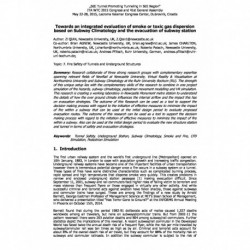Cart
0
0
No document
0,00 €
Total
Document successfully added to your shopping cart
Quantity
Total
There are 0 items in your cart.
There is 1 item in your cart.
Total documents
Total shipping
To be determined
Total
Search & filter
Search for a publication
Search & filter
Towards an integrated evaluation of smoke or toxic gas dispersion based on Subway Climatology and the evacuation of subway station
wtc2015_full_qian-2
Z. Qian / B. Agnew / J. Charlton / R. Palacin / A. Pflitsch
The first urban railway system and the world's first underground line (Metropolitan) opened on 10th January, 1883, in London to cope with population growth and increasing traffic congestion. Underground railway systems have become one of the important facilities of urban transportation however there is tremendous potential danger once a fire occurs in a subway system or a tunnel. These types of fires have some distinctive characteristics such as complicated burning process, rapid spread and high temperatures that disperse smoke very quickly. This creates problems in narrow and enclosed underground station passages [1] making evacuation difficult. Since September 11, 2001, subway and rail commuters face higher risks of falling victim to terrorism and mass violence than frequent flyers or those engaged in virtually any other activity. And while successful criminal and terrorist acts against aviation have fallen sharply, those against subways and commuter trains have surged. These are among the findings of a new study by Arnold Barnett, George Eastman Professor of Management Science at MIT’s Sloan School of Management, who delivered a presentation titled “Has Terror Gone to Ground?” at the INFORMS Annual Meeting in Phoenix on October 15th, 2014. Barnett found that during the period 1982-91 deliberate acts of malice caused 1,327 deaths worldwide among air travelers, but none on subways/commuter trains. But from 2002-11 the pattern reversed: there were 203 aviation deaths and 804 among subway/rail commuters. Further statistics depict the implications of this reversal. A recent subway/rail commuter in the Developed World has faced twice the annual death risk of a frequent flyer, while the risk per mile travelled by subway/commuter rail was ten times as high as by air. Criminal and terrorist acts account for about 8% of the overall death risk of air travel, but they account for 88% of the mortality risk on subways and commuter railroads. In addition the subway commuter is subject to the risk of




